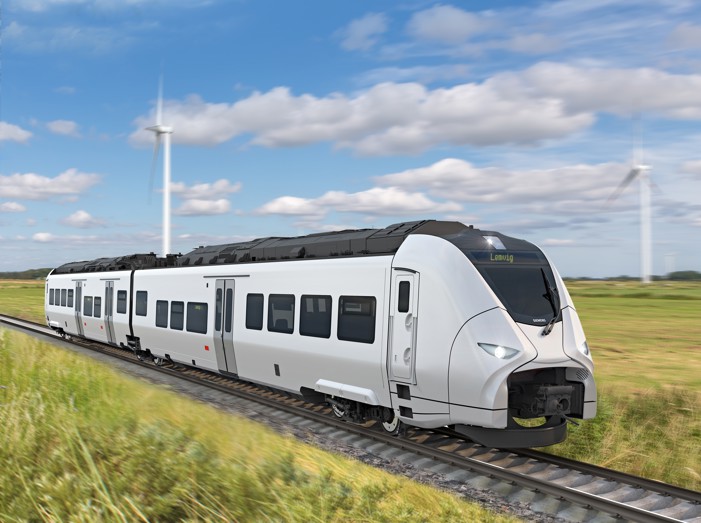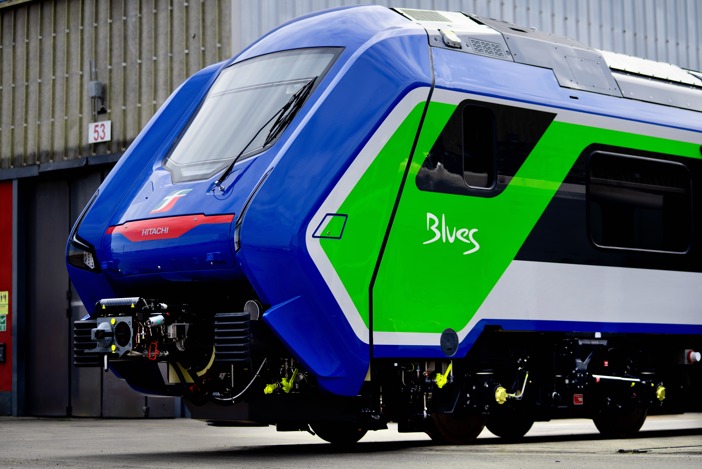Fast-charging, and exceptionally powerful, lithium-ion batteries have been used for years to power mobile devices and electric vehicles (EVs). In the rail industry, battery-powered trains have also been around for years, but it is only in recent times that the sector is starting to see the widespread roll-out of the environmentally friendly locomotives. Hitachi, Siemens, Stadler and many other manufacturers have designed lithium-ion battery-powered trains that are now regularly transporting passengers.
Perhaps tempering the excitement about the potential for more environmental rail travel via battery-power, however, are anxieties about safety caused by well-publicized battery fires in EVs and mobile phones.
Electrical car fires linked to batteries have been on front pages and shared widely on social media. As recently as January 2023, a Tesla Model S car battery spontaneously caught fire on a freeway in California and required 6,000 gallons of water to extinguish. In 2021, General Motors conducted a recall of Bolt EVs and Bolt EUVs to address the risk of battery fires.
Stories of this kind are few and far between in the rail sector. In 2017, a battery caught fire during the testing of a Siemens Charger locomotive on Amtrak’s Hiawatha Service between Milwaukee and Chicago. No injuries were reported in this incident, which saw a fire break out in the battery box of the Charger and then quickly extinguished, but it did highlight the importance of extensive safety tests and failsafe mechanisms before a battery-powered train can be put into passenger operation.

Siemens' Mireo Plus B battery train features "very high safety standards through the use of the right cell type and chemistry, proven to be safe on the railway," said Dirk Schoenberger, head of battery trains at Siemens Mobility. The Mireo Plus B's safety features include fire protection barriers, linear heat detectors, pressure relieve mechanisms in battery modules and containers, and SIL classified battery management systems to ensure safety.
Learnings from the automotive sector
For the rail industry, there are positive aspects to the automotive sector’s battle to mitigate risks and deflate battery safety anxieties. A lot of research into avoiding fire risks has already been done. “The biggest issue for automotive has been that battery fires, often from crashes, have led to thermal runaway in the batteries that could not be extinguished and eventually destroyed the vehicles,” says Tony Cash, international president of the Rail Industry Fire Association.
“From these fires, lessons were learned, and battery systems manufacturers started developing modular structures to stop the risk of thermal runaway. Vehicle manufacturers also saw the need to protect the batteries from impact and collision damage, so location and enclosure became a part of the standard design,” Cash adds.
The EV manufacturers’ research is also being carefully assessed by the UK’s Rail Safety and Standards Board (RSSB) which provides regulations and advice for the rail industry. Robert Shemilt, lead rolling stock systems and assurance engineer, agrees that the automotive sector has provided the most “convenient testbed” for rail as many of the risks are similar.
“In the event of rail collisions, the cells, or battery as a whole, are exposed to a risk of being crushed, or fracturing. The deformation of the metal container could potentially cause short circuiting of cells,” he says. “Each of those risks has an analogous situation in the automotive sector and has been thoroughly researched.”
Battery manufacturers have outlined in precise detail, for example, how to carry out nail puncture tests, in which a device fires a nail into a cell to see whether there is a continuous fire, or it burns out. “It’s a question of looking at the research and validating it for rail. It will then be integrated into rail-specific standards, especially EN 45545, which governs fire safety across Europe.”
Propelling trains demands huge amounts of energy and lithium-ion batteries, Shemilt says, are currently the “only name in the game”. But they do come with unique challenges. “With a battery, you have fuel plus ignition, plus, in the case of lithium-ion, oxygen, all contained within the same little package. If you wanted to fit something to a train that was designed to burn efficiently, a battery fits that niche very nicely,” he says. “The nature of a lithium-ion fire is different from what we’ve seen on rolling stock before. The risk is of a jet fire effect when a cell over-pressurizes and vents gas, and then the gas combusts in free air due to other sources of ignition.”
Battery-powered trains in operation
The first fleet of battery electric multiple units in full revenue service was the EV-E301 in Japan, operated by East Japan Railway Company on the Karasuyama Line and Tohoku Main Line since March 2014. Then in 2016, Kyushu Railway Company (JR Kyushu) and Hitachi Rail introduced the BEC819 series trains, now known as Dencha – the world’s first battery-powered passenger train charged by AC overhead lines.
Since then, there have been several battery-powered trains put into operation. One of the first high-speed trains to use a lithium-ion propulsion system was the Central Japan Railway’s N700S bullet train on the Tokaido Shinkansen line between Tokyo and Shin-Osaka in July 2020. The main purpose was to provide auxiliary power if an earthquake caused a power cut, but it can also power the train as it comes in and out of stations.
In Italy, meanwhile, Hitachi Rail has developed a battery hybrid train for national operator Trenitalia. The first “Blues” trains went into service in Sicily in December 2022, and there will be 135 in all at a cost of €1.2bn. Claimed to be Europe’s first tri-modal train, the trains can also operate with diesel engines on non-electrified lines.

The battery cell used in Hitachi's hybrid Blues train has a track record of zero fire incidents across the past 10 years.
Swiss manufacturer Stadler Rail last year unveiled the Flirt Akku which has a range of 150km under battery power, a top speed of 160km/h and can charge fully from overhead line equipment in 15 minutes. In the US, where it’s not possible to charge from an overhead cable, Stadler is developing a battery-only train with help from Utah State University and the Aspire Engineering Research Centre. Meanwhile, Siemens has designed the Mireo Plus B battery-powered trains that are running in Germany and Denmark.
Battery testing
All these companies have carried out rigorous testing to ensure the safety of the lithium-ion batteries in accordance with EN 45545, and other standards. “Battery cells are tested for overcharging, short circuit, and puncturing, then modules are tested to show that a fire generated in one cell does not spread from module to module,” says Cash.
“The battery management system (BMS) itself must be tested to ensure it correctly registers overvoltages or temperature increases in the cells, and that it shuts off the power to the cells. If necessary, the BMS and system software may need to be safety integrity level (SIL) rated. As an additional measure, gases from the batteries are tested to ensure levels of toxicity below internationally agreed limits,” he adds.
In contrast to older lead-acid batteries, lithium-ion batteries are fully sealed, which means there is no leakage risk if a train derails. “Puncture tests are designed to show that even if a battery cell is punctured and flames, it will not start a thermal runaway to other cells,” Cash says.
In addition, most battery modules are fitted with a liquid cooling system that removes excess heat and means they can operate up to around 65°C. Once this temperature is exceeded the BMS will shut down the batteries.
Limiting the risk of a fire
The location of the batteries also plays a major role in ensuring their safety, Cash notes. The best site is within a separate area in the vehicle body, which protects them from being crushed. An alternative location is on the roof as far away as possible from the front cab.
“In a severe collision, batteries could be crushed, allowing multiple cells to catch fire. But the use of solid enclosures, especially fire-resistant ones, limits the risk of a fire, and the extent of fire spread. Installing batteries under a vehicle requires a solid casing to guard against any crushing if the vehicle derails and prevent any punctures from debris that could be thrown up by the train,” Cash says.
In Japan, the N700S batteries are attached to the undersides of its carriages, considered the best place to withstand seismic shocks.
Paolo Diana, fire safety officer at Trenitalia, says all components of the Hitachi-manufactured Blues’ trains battery systems were tested at the Italian Fire Testing Laboratory (Lapi), in Prato, Tuscany. “We tested the fire detection system according to Italian standard UNI 11565, which meant it had to detect fire within 60 seconds,” he says.
“We recreated the battery case and installed the linear heat detection system like in a real fire. Once we had our mock-up, we used a fire source and monitored whether the system detected it within a minute. We also tested the fire resistance of the case under EN 45545-3. That involved placing it inside a huge furnace of the sort you could witness after a real-life collision,” Diana adds.
More tests were carried out on the sensors that monitor the temperature inside the cabinet, he says. If overheating occurs, indicating a malfunctioning of the battery, the sensor shuts it down. Despite all the mitigation measures, Diana believes the most important aspect of safety is managing and maintaining the batteries carefully. “Fires become far more likely when battery systems are damaged,” he says.
Best practices
Despite the rigorous testing, no part of the EN 45545 standard applies specifically to lithium-ion batteries. Neil Dinmore, RSSB principal engineer of structures and material, says it needs to be updated, but it is a slow process. “It’s always a challenge to keep pace with emerging technologies. Any designer proposing new technology will have the risk assessment peer-reviewed, or independently assessed. If there are new risks, they must prove they are adequately mitigated. It can’t be rushed, and we must guard against over-regulation.”
RSSB, and its EU partners, will be evaluating lithium-ion batteries later this year, but it can take up to three years before modifications are published in agreement with the equivalent bodies in the EU. Because of the lengthy process, RSSB recently adopted the practice of issuing rapid response guidance in the form of technical notes to ensure manufacturers can continue to carry out risk assessments in an educated manner.
Neil Dinmore says the notes offer advice about “what to look out for, what to consider in the design and the best maintenance procedures”. A technical note on batteries will be published shortly.
“Recommendation 20 of the UK Government’s Carmont Report was to investigate the interaction of the auxiliary batteries with the fire on the train. That’s a small, basic subject, but we thought we’d take the opportunity to expand it into looking at batteries as a whole and tie it into our ongoing research on lithium-ion batteries,” Dinmore concludes.
This article first appeared in the March 2023 issue of Electric & Hybrid Rail Technology magazine. To read the full issue, click here.

